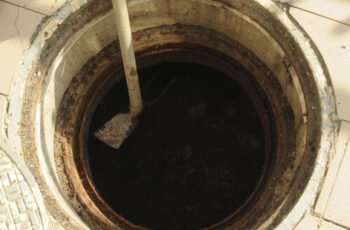Living in a particular area means abiding by certain regulations, and when it comes to septic systems, it’s important to understand what rules and guidelines you need to follow. Whether you’re a homeowner or a potential buyer looking to invest in property, knowing the regulations for septic systems in your area is crucial for maintaining a safe and healthy environment. From understanding setback distances to permit requirements, this article will provide you with a comprehensive overview of the regulations you need to be aware of when it comes to septic systems in your area.

This image is property of images.pexels.com.
Types of Septic Systems
Conventional Systems
Conventional septic systems are the most common type of septic system used in residential areas. They consist of a septic tank and a drainfield, also known as a leachfield. The septic tank is designed to separate solid waste from the wastewater, allowing the solids to settle at the bottom of the tank. The wastewater then flows into the drainfield, where it is distributed into the soil and treated naturally.
Alternative Systems
Alternative septic systems are designed for properties with specific challenges, such as steep slopes or high water tables. These systems utilize different technologies to treat the wastewater and can include options such as aerobic treatment units (ATUs), mound systems, or drip dispersal systems. Alternative systems often require additional maintenance and monitoring compared to conventional systems.
Mound Systems
Mound systems are typically used in areas with poor or shallow soil conditions. In this type of system, an above-ground mound is constructed to raise the absorption area. The wastewater is pumped up to the mound and then distributed evenly over the surface, allowing for enhanced treatment and soil absorption.
Aerobic Treatment Units (ATUs)
Aerobic Treatment Units, or ATUs, are advanced septic systems that use oxygen to break down and treat the wastewater more efficiently than conventional systems. These systems contain aeration chambers where bacteria break down the waste, resulting in cleaner effluent. ATUs are often required in environmentally sensitive areas or for properties with high water tables.
Drip Dispersal Systems
Drip dispersal systems are a type of alternative septic system that utilizes drip irrigation technology to distribute the treated wastewater. In this system, small, low-volume emitters deliver the effluent directly into the soil, promoting optimal treatment and absorption. Drip dispersal systems are ideal for properties with limited space or poor soil conditions.
Permitting and Inspection Process
Obtaining a Permit
Before installing a septic system, you will need to obtain a permit from your local health department or relevant authority. The permitting process typically involves submitting an application, providing site plans, and paying any required fees. It’s important to familiarize yourself with the specific requirements and regulations in your area to ensure a smooth permit application process.
Design and Construction Plans
When applying for a septic system permit, you will need to provide detailed design and construction plans for your system. These plans should include the location of the septic tank, drainfield, and any alternative system components. The plans must meet local health department guidelines and demonstrate that the system will be designed and installed to code.
Inspection Requirements
During the installation process, your septic system may need to undergo inspections at various stages. These inspections ensure that the system is being installed correctly and meets the necessary regulations. Inspections may include checks on the septic tank, drainfield, and any alternative system components. It is essential to comply with these inspection requirements to avoid delays or penalties.
Operating Permit
After the installation is complete, you may be required to obtain an operating permit for your septic system. This permit is typically renewable on a regular basis, such as every one to two years. The operating permit ensures that your system continues to function properly and meets the health and safety standards set by the local authority.
Renewal and Fees
To maintain your operating permit, you will need to renew it within the specified timeframes and pay any associated fees. The renewal process may require documentation of maintenance or inspection records, depending on your local regulations. It is important to keep up with the renewal schedule and budget for any fees to stay in compliance with the septic system regulations in your area.

This image is property of images.pexels.com.
Setbacks and Siting Requirements
Distance from Wells and Surface Water
Septic systems must be located at a safe distance from wells and surface water sources, such as rivers, lakes, or ponds. This requirement is in place to prevent contamination of the water supply. The specific setback distances can vary depending on local regulations, but they generally range from 50 to 100 feet. It is crucial to consider these setbacks when siting your septic system to ensure the protection of water resources.
Distance from Buildings and Property Lines
Another consideration when siting a septic system is the distance it must be from buildings and property lines. The exact setbacks can vary depending on local regulations, but they are typically designed to prevent issues such as odor, noise, or potential damage to structures. It is important to consult the specific setback requirements in your area and plan the placement of your septic system accordingly.
Distance from Paved Surfaces and Pre-existing Structures
Septic systems should be situated away from paved surfaces, such as driveways or parking lots, to prevent any damage that could occur during construction or maintenance activities. Additionally, the septic system should be located at a safe distance from pre-existing structures to ensure their stability and avoid any potential disruption. Familiarize yourself with the local regulations regarding setbacks from paved surfaces and pre-existing structures to meet the necessary requirements.
Tank and Drainfield Specifications
Tank Capacity and Material
The septic tank is a critical component of a septic system, responsible for separating solids from wastewater and allowing for the treatment process to occur. The tank’s capacity should be appropriate for the size of the property and the anticipated wastewater flow. Common tank materials include concrete, fiberglass, or plastic, with each offering different advantages and disadvantages. Consult local health department guidelines to determine the appropriate tank capacity and material for your septic system.
Drainfield Design and Sizing
The drainfield, also known as the leachfield, is responsible for the final treatment and absorption of the wastewater. The design and sizing of the drainfield are crucial to ensure optimal treatment and prevent any potential issues, such as waterlogging or system failure. Factors such as soil type, percolation rates, and anticipated wastewater flow must be considered when designing and sizing the drainfield. Consult with a professional designer or engineer experienced in septic system installations to ensure compliance with local regulations.
Pressure Distribution Systems
Some septic systems may require the use of pressure distribution systems to evenly distribute the effluent over the drainfield. These systems use pumps or other techniques to maintain consistent pressure throughout the drainfield, allowing for efficient treatment and absorption. The specific requirements for pressure distribution systems can vary, so it is important to consult local regulations and work with a knowledgeable professional during the design and installation process.
Effluent Filters
Effluent filters are an important component of septic systems, designed to capture and prevent solids from entering the drainfield. Proper maintenance and cleaning of the effluent filters are essential to ensure their effectiveness. Local regulations may specify the use of effluent filters and provide guidelines for their maintenance. It is important to properly install and maintain these filters to prolong the lifespan of the drainfield and prevent costly repairs.
Alarm Systems
In some cases, septic systems may require the installation of alarm systems to alert homeowners of any issues or malfunctions. These alarm systems can detect high water levels in the tank, pump failure, or other potential problems. The specific requirements for alarm systems, including their type and placement, can vary depending on local regulations. It is important to consult with professionals and adhere to the local guidelines to ensure the smooth operation of your septic system.

This image is property of images.pexels.com.
Maintenance and Pumping
Pumping Frequency
Regular pumping of the septic tank is essential to prevent solids from accumulating and reaching the drainfield. The frequency of pumping depends on factors such as the tank size, household size, and water usage. As a general guideline, it is recommended to have the septic tank pumped every 3 to 5 years. However, specific regulations and recommendations may vary based on local conditions. Consult your local health department or septic system professional to determine the appropriate pumping frequency for your system.
Licensed Pumping Contractors
When it comes to septic tank pumping, it is important to hire licensed and experienced pumping contractors. These professionals have the knowledge and equipment to safely remove the sludge and scum from the tank without causing damage. They can also inspect the tank and provide recommendations for maintenance or repairs if needed. Research and choose reputable pumping contractors who are licensed and bonded to ensure the proper care of your septic system.
Proper Disposal of Pumped Waste
After the septic tank is pumped, the waste must be properly disposed of at a designated facility. It is illegal and harmful to the environment to dump the waste in unauthorized locations. Licensed pumping contractors are responsible for disposing of the waste at approved treatment or disposal facilities. Ensure that the contractor you hire follows proper disposal practices to prevent environmental contamination and adhere to local regulations.
Maintenance Inspections
In addition to regular pumping, septic systems require ongoing maintenance inspections to ensure their proper function and identify any potential issues. These inspections typically involve checking the tank levels, inspecting the drainfield, and assessing the overall system performance. The frequency of maintenance inspections may vary based on local regulations and system requirements. Work with a qualified professional to schedule regular inspections and address any maintenance needs promptly.
Repair and Replacement Cost
Maintenance and repairs are inevitable for septic systems over time. The cost of repairs or system replacement can vary depending on the extent of the issue and the specific components involved. It is important to budget and prepare for potential repair and replacement expenses to avoid financial strain. Consider setting aside funds for regular maintenance, and obtain homeowner’s insurance coverage that includes septic system repairs, if available. Consult professionals to estimate potential repair or replacement costs based on the specific characteristics of your system.
Environmental and Health Concerns
Contamination of Groundwater
Improperly designed or malfunctioning septic systems can lead to the contamination of groundwater, a vital source of drinking water. When the groundwater is contaminated, it can pose significant health risks to individuals and communities. Proper septic system installation, maintenance, and monitoring are crucial to prevent groundwater contamination. Adhering to local regulations and seeking professional guidance will help ensure the protection of groundwater and the health of both you and your community.
Surface Water Pollution
Septic systems that are sited too close to surface water bodies can contribute to pollution and harm aquatic ecosystems. Nutrients and pathogens present in the untreated wastewater can seep into rivers, lakes, or ponds, causing water quality degradation and potential health hazards for humans, animals, and plants. It is important to follow setback requirements and consider the potential impact on surface water when siting your septic system. This will help protect the local environment and ensure the sustainability of the ecosystem.
Soil Erosion and Runoff
Improperly installed or maintained septic systems can contribute to soil erosion and runoff. When wastewater is not treated and absorbed properly, it can cause excess moisture in the soil, leading to erosion and runoff. The erosion can degrade the soil quality and damage nearby vegetation. By adhering to septic system regulations and implementing proper maintenance practices, you can minimize the risk of soil erosion and runoff, protecting the natural environment surrounding your property.
Health Risks Associated with Septic Systems
Malfunctioning or inadequately maintained septic systems can pose health risks to individuals living on the property. Exposure to untreated or poorly treated wastewater can lead to the transmission of waterborne diseases and infections. It is important to be aware of the potential health risks associated with septic systems and take appropriate measures to ensure their proper function. Maintaining regular inspections, pumping, and maintenance, as well as following the recommendations from local health departments, will help safeguard the health of you and your household.
Impact on Property Value
The condition and functionality of a septic system can have an impact on the value of a property. A well-maintained, properly functioning septic system can enhance property value, while a failing or non-compliant system may decrease its value. When buying or selling a property with a septic system, it is important to consider these factors and ensure that the system is in good condition. Obtaining an inspection and addressing any necessary repairs or upgrades can help maintain or improve the property value.
Special Considerations
Floodplain Areas
If your property is located in a floodplain area, special considerations must be taken when designing and installing your septic system. Floods can cause significant damage to septic systems, leading to system failure and environmental contamination. In floodplain areas, elevated septic systems or flood-resistant components may be required. Consult local regulations and work with professionals familiar with floodplain requirements to ensure the proper functioning and durability of your septic system.
High Water Tables or Poor Soil Quality
Properties with high water tables or poor soil quality may present challenges for septic system installations. The saturation of the soil from the high water table or the lack of suitable soil can hinder the proper treatment and absorption of wastewater. Alternative septic system options, such as mound systems or ATUs, are often recommended in these situations. Consulting with septic system professionals familiar with such conditions will help identify the best solution for your property.
Historic or Protected Sites
If your property is located in a historic or protected site, additional regulations may apply to the installation and maintenance of septic systems. These regulations aim to balance the preservation of cultural or environmental resources with the need for proper sanitation. Design and placement considerations may be necessary to ensure minimal impact on the site’s integrity. Consult with local historic preservation agencies or environmental authorities to determine the specific requirements for septic systems in these areas.
Alternative Water Sources or Water Conservation Systems
In some areas, alternative water sources or water conservation systems are encouraged or required. These systems reduce the strain on water resources by reusing treated wastewater for non-potable purposes, such as irrigation or toilet flushing. If you are interested in implementing an alternative water source or water conservation system in conjunction with your septic system, research the local regulations and consult with professionals experienced in these technologies to ensure compliance and optimize resource efficiency.
Graywater Systems
Graywater systems collect and treat non-toilet wastewater, such as from sinks, showers, and washing machines, for reuse. These systems can help reduce water consumption and alleviate strain on septic systems. If you are considering incorporating a graywater system into your property, research and comply with the local regulations and guidelines. Proper design, maintenance, and usage of graywater systems are essential for effective wastewater treatment and utilization while safeguarding public health and the environment.
Proper Use and Care
Prohibited Items and Chemicals
To maintain the proper function and longevity of your septic system, it is important to be mindful of what goes down the drain. Avoid flushing or draining items such as grease, oil, paper towels, diapers, cigarette butts, chemicals, or excessive cleaning products. These items can clog the system, hinder the treatment process, and potentially cause system failure. Follow the local regulations and educate household members and visitors on the importance of proper waste disposal practices to minimize any adverse effects on your septic system.
Water Conservation Practices
Conserving water can significantly reduce the strain on your septic system. Implementing water-efficient fixtures, such as low-flow toilets and showers, and practicing simple water conservation habits, such as fixing leaks and only running full loads of laundry or dishes when using water, can help minimize the volume of wastewater entering the system. Conserving water not only benefits your septic system but also contributes to the overall conservation of water resources and lowers the associated costs.
Avoiding Excessive Water Usage
Excessive water usage can overwhelm your septic system, leading to inadequate treatment and increased risk of system failure. Be mindful of water usage habits, such as avoiding long showers or running multiple water-intensive activities simultaneously. Using water-efficient appliances and fixtures can also contribute to reducing water consumption. Remember that every drop counts, and practicing water-conscious habits will help maintain the integrity and functionality of your septic system.
Proper Disposal of Household Waste
In addition to avoiding prohibited items, it is important to ensure that household waste is disposed of properly to prevent any adverse effects on your septic system. This includes avoiding pouring cooking oil or grease down the drain, disposing of food waste in the garbage instead of the sink, and not using the toilet as a trash can. Proper waste disposal helps prevent clogs, maintains the system’s efficiency, and avoids unnecessary strain on your septic system.
Educating Household Members
Proper education and awareness among household members are crucial for the successful operation and maintenance of your septic system. Teach everyone in your household about the dos and don’ts of septic system use, including the proper disposal of waste, water conservation habits, and signs of potential issues. Encourage responsible habits and emphasize the importance of regular maintenance and inspections. By fostering a culture of awareness and accountability, you can prolong the lifespan of your septic system and minimize the risk of costly repairs.
Enforcement and Penalties
Violation Reporting Process
If you suspect a violation of septic system regulations in your area, it is important to report it to the appropriate authorities. Local health departments or environmental agencies typically handle the enforcement of septic system regulations. Familiarize yourself with the reporting process in your area, which may involve submitting a formal complaint or contacting a specific department. Reporting violations helps protect public health and the environment and ensures the effective enforcement of septic system regulations.
Enforcement Agencies
Enforcement agencies are responsible for overseeing compliance with septic system regulations and taking appropriate actions in case of violations. These agencies can include local health departments, environmental agencies, or other relevant authorities. They conduct inspections, respond to complaints, and may issue citations or penalties for non-compliance. Know the enforcement agencies in your area and their contact information to address any concerns or inquiries regarding septic system regulations and enforcement.
Potential Penalties and Fines
Non-compliance with septic system regulations can result in penalties and fines. The specific penalties and fines depend on the local regulations and the nature and severity of the violation. Penalties can range from warnings and corrective actions to monetary fines or even legal action. To avoid penalties and fines, it is important to understand and follow the regulations, obtain necessary permits, and maintain your septic system in compliance with local requirements.
Appeals and Legal Processes
If you receive a violation notice or disagree with an enforcement decision regarding your septic system, you may have the option to appeal or follow specific legal processes. Each jurisdiction may have its own procedures and requirements for appeals and legal actions. Familiarize yourself with the local regulations and consult with professionals or legal advisors experienced in septic system matters if you need guidance on appealing a decision or navigating legal processes.
Community Education and Outreach
Community education and outreach efforts play a crucial role in promoting awareness of septic system regulations and encouraging compliance. Local health departments, environmental organizations, and educational institutions often organize workshops, seminars, or informational campaigns to raise awareness and provide resources on proper septic system use and care. Participating in these initiatives, whether as a homeowner or a community member, helps create a culture of responsible septic system management, fostering a healthier environment for everyone.
Local Variations and Resources
Local Health Department Requirements
Local health departments are key resources for understanding the specific regulations and requirements for septic systems in your area. They oversee the permitting, inspection, and enforcement processes and can provide guidance on design, installation, maintenance, and repairs. Contact your local health department to obtain the most up-to-date information and resources related to septic system regulations and compliance in your community.
County or Municipality Regulations
In addition to state or provincial regulations, counties or municipalities may have their own specific rules and regulations regarding septic systems. These additional requirements can include setback distances, permitting processes, or inspection procedures. It is important to consult the regulations for your specific county or municipality to ensure compliance with the local rules and consider any additional considerations for your septic system.
State Environmental Agencies
State environmental agencies are responsible for overseeing environmental protection and regulating septic systems at a broader level. They may establish and enforce statewide regulations, provide guidance and educational resources, or conduct research on septic system technologies and practices. State environmental agencies can serve as valuable sources of information and facilitate compliance with septic system regulations. Research and connect with your state environmental agency to access relevant resources and stay updated on any changes or developments in septic system regulations.
Professional Septic System Organizations
Professional organizations dedicated to septic system installation, design, maintenance, and inspection can offer valuable resources and expertise. These organizations provide training, certification programs, and industry standards to ensure proper septic system practices. Consulting with professionals affiliated with these organizations can help ensure compliance with regulations and access the latest knowledge and technologies in septic system management.
Educational Materials and Courses
Numerous educational materials, courses, and online resources are available to help homeowners understand and navigate septic system regulations. These resources can include informational brochures, guides, videos, or online courses offered by government agencies, environmental organizations, or septic system professionals. By educating yourself about septic system regulations and best practices, you can effectively maintain your system, protect the environment, and ensure the health and well-being of your household.

